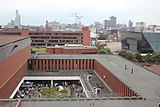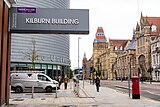Kilburn Building
 From Wikipedia the free encyclopedia
From Wikipedia the free encyclopedia
| The Kilburn Building | |
|---|---|
 The Kilburn Building seen from the Oxford Road in 2011 | |
 | |
| Former names | Computer Building |
| General information | |
| Location | 53°27′50″N 2°13′51″W / 53.4639°N 2.2308°W |
| Construction started | 1969[1] |
| Completed | 1972 |
| Cost | £1.5 million[1] |
| Owner | University of Manchester |
| Technical details | |
| Size | 76 by 76 metres square |
| Design and construction | |
| Architect(s) | Building Design Partnership |
| Website | |
| www | |
The Kilburn Building is a building on the Oxford Road in Manchester which is home to the Department of Computer Science at the University of Manchester. The building was designed by the Building Design Partnership and completed in 1972,[2] with three storeys[3] in a square shape, measuring 76 by 76 metres.[4][1][5] The building was formerly known as the Computer Building changing its name in 2001 in honour of Tom Kilburn who died in the same year.[6]
Architecture and history[edit]
The Pevsner Architectural Guide describes the Kilburn building as a "big aggressive box of brick pier and vertical window strips"[4] which has also been likened in appearance to a giant brick Central processing unit (CPU) heat sink. The second floor features an Auguste Perret style paved piazza which initially featured a fibreglass structure known as the floating point zero.[4][7]
Up until 2015, the building was connected to Manchester Business School, via the Precinct Centre and Bridge on the North Side of the building over the Oxford Road (demolished in 2015).[8] To the South, the building was connected by another pedestrian walkway (referred to as a dismal corridor in Pevsner)[4] to the Mathematics Tower, Manchester which was demolished in 2005.
The pedestrian walkways initially formed part of a futuristic but ultimately unsuccessful vision of streets in the sky to link Manchester Oxford Road railway station and out to the Hulme Crescents in Hulme and also to Ardwick.[9]
The building was extended on the east side by the information technology (IT) building which was officially opened by Anne, Princess Royal in 1988.
Some of the first computers housed in the building were the CDC 7600 and the 1906AICT 1900 series from International Computers Limited (ICL).[10]
The cornbrook, a culverted river which drains the urban area South of the River Medlock, flows under the Kilburn building on its way from Gorton to the Manchester Ship Canal at the Pomona Docks.[11][12][13]
Gallery[edit]
Images of the Kilburn building can be seen in the gallery below:
- Looking North over the Kilburn Building towards the City from University Place, with Manchester One and
- Picture showing "big aggressive box of brick pier and vertical window strips"[4]
- Looking South down the Oxford Road past University place and the Kilburn building sign
- The Kilburn Building in 2009
- The Auguste Perret style paved piazza at the centre of the building, pictured in 2016 with white floating point sculpture features
- A rainbow over the Kilburn Building in 2014, picture by Toby Howard
References[edit]
- ^ a b c Pullan, Brian; Abendstern, Michele (2000). A History of the University of Manchester 1951-73. Manchester University Press. ISBN 9780719056703. OCLC 59581673.
{{cite book}}:|website=ignored (help) - ^ Anon (2002). "The Kilburn Building". manchesterhistory.net.
- ^ Anon (2010). "Kilburn building floorplans". manchester.ac.uk. Archived from the original on 8 October 2018.
- ^ a b c d e Hartwell, Clare (2001). Manchester: Pevsner Architectural Guides. London: Yale University Press. ISBN 9780140711318. OCLC 47232929.
- ^ Anon (2023). "How to find us". cs.manchester.ac.uk.
- ^ Wilkes, Maurice; Kahn, Hilary J. (2003). "Tom Kilburn CBE FREng. 11 August 1921 – 17 January 2001". Biographical Memoirs of Fellows of the Royal Society. 49: 283–297. doi:10.1098/rsbm.2003.0016. S2CID 71234844.
- ^ Anon (2010). "Kilburn Building Stock Photos and Images". alamy.com. Alamy.
- ^ Anon (2015) Precinct Bridge Demolition: University of Manchester on YouTube
- ^ Williams, Jennifer (2015). "Revealed: The utopian 1960s vision for Manchester that never took off". manchestereveningnews.co.uk. Manchester: Manchester Evening News. Archived from the original on 9 April 2016.
- ^ Lavington, Simon (1998). A History of Manchester Computers (2nd ed.). British Computer Society. ISBN 9781902505015. OCLC 156380308.
- ^ Anon (2022). "The culverted Cornbrook river". hidden-manchester.org.uk. Archived from the original on 23 July 2021.
- ^ Anon (2019). "Cornbrook Manchester - Rebooted". 28dayslater.co.uk. Archived from the original on 21 February 2020.
- ^ Anon (2008). "Cornbrook Drain". substormflow.com. Archived from the original on 31 May 2015.

![Picture showing "big aggressive box of brick pier and vertical window strips"[4]](http://upload.wikimedia.org/wikipedia/commons/thumb/5/5d/Kilburn_Building.jpg/160px-Kilburn_Building.jpg)




